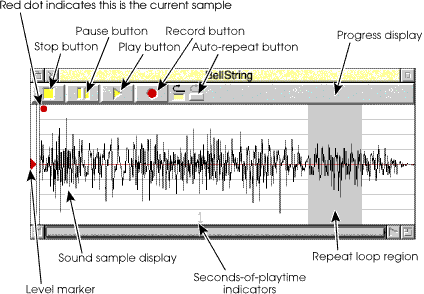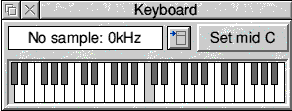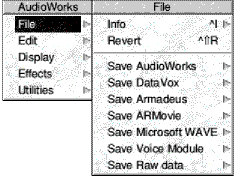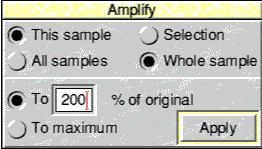



AudioWorks
The complete manual...
Tutorial
Let's get started. Double-click on !AudioWrks to run the application. The AudioWorks icon appears on the right hand side of the icon bar.
Double-click the example sound sample BellString or drag it onto the AudioWorks icon on the icon bar) to load the sound. This opens a window:

The Tool Icons
The Stop, Pause, Play and Record buttons act just like buttons on tape-recorders. That is,
- click on Play to start playing the sample.
- click on Pause to pause playing, click again to resume playing.
- click on Stop to stop playing.
- The Record button is used to record your own sounds; its use is described later in Creating and Recording samples.
As the sound sample plays, a vertical play cursor runs across the display showing which part of the sound you are currently hearing.
This particular sound is a musical instrument, and part or all of it can be played continuously using a repeat loop (the editing of which is described later). The pre-set repeat loop is shown in the above picture as a light grey background on the right-hand side of the sound sample.
- Click on the auto-repeat button. This changes the playback mode to continuously repeat the looped section.
- Click Play again to see (or rather, hear) the effect. You have to click Stop to stop playback this time (otherwise it repeats forever).
- Clicking again on auto-repeat resets the playback mode to playing the sample once only.
Positioning the cursor
Clicking in the sample window displays a vertical bar at the point where you click. This is the cursor and is used for operations such as pasting in samples. (Pasting is described later.)
Selecting part of a Sound Sample
Drag Select inside the sample display to select a region of the sound. As you drag in the white area of the window, the selection is shown inverted, as is usual in RISC OS. As with most applications, you can also adjust the current selection by dragging or clicking with Adjust.
You will notice that, as you drag, the progress display in the top right of the window displays how many samples you have selected and the total number of samples in the sound. This tells you the size of the selection.
Shift Left Arrow selects from the cursor or start of the selected region to the start of the sample. Shift Right Arrow selects to the end.
Pressing the Play button now plays just the selected region. By default, effects and editing options also apply just to the selection.
Click in the sound display to clear the current selection.
If you Shift-click in the sound display, AudioWorks selects the entire sound sample.
The Level Marker
Across the middle of the window is a red line, with a red triangle at the left end. This is the level marker, used by some editing options as a convenient way of setting levels.
By dragging close to the left of the window you can move this marker up and down (even if the red triangle has been scrolled out of sight).
The Keyboard window
Move the mouse pointer over the AudioWorks icon bar icon and click Menu. This displays the icon bar menu. Choose Keyboard... This opens a window:

Now, you can play BellString at different pitches by clicking on the piano keyboard display. You can also type on the computer keyboard as in this diagram:

The Sample Menu
Click Menu anywhere inside the sample display window to display the sample menu. Move across the arrow of the first item File:

The Sample menu section details this menu. For now, continue across the arrow of Info. This displays information on the sound:
Now that we know a little more about our sample, let's apply an effect to it.
Press Esc to remove the information window.
Click once in the sample display (or press Ctrl-Z) to cancel any selected region.
Now, bring up the Sample Menu again, but this time, choose Effects then Amplify. This brings up a dialogue box:

At this stage, ignore the buttons in the top half of the window. Below them, we have a choice of either amplifying 'to 200% of original' or 'to maximum'. Let's leave the settings as they are, which will amplify the sound to twice (200% of) its current volume level. Click the 'Apply' button (or press Return) to apply this amplification to the sound.
The progress display in the top right of the sample window briefly shows a message 'Amplifying by 200%' with a percentage-complete indication. AudioWorks applies all effects in the background, so that applying effects on large samples does not take over your machine for seconds at a time. The message reminds you what is being done, and shows how much of the task has been completed. In the meantime, you can continue to use the computer and AudioWorks for other things, without having to wait for processing to complete. Often, however, it'll finish before you have time to do anything.
You can now play the sample again to hear the effect of the amplification.
Close the sample display window, by clicking the Close icon (in the top left corner). As you have modified the sample, AudioWorks checks if you really want to discard it:

When this appears, you can do any of the following:
- Discard the sound Clicking the Discard button, or pressing Return , discards the modified sample. Any modifications made since loading the sample are lost.
- Save the sound Clicking on the Save button saves the sample before you discard it, using the familiar Save-as dialogue box. (See The Sample Menu for more information on saving.)
- Cancel, and return to editing Clicking the Cancel button, or pressing Esc cancels the close and returns you to editing the sample. You can also cancel by clicking outside the dialogue window.
We don't want to overwrite BellString so click 'Discard' to throw away the sample.
You now know most of the principles for using AudioWorks. You might like to spend some time playing some of the other example sampled sounds included.
You can try the other effects. Remember to click the Discard option to avoid overwriting the supplied samples. Take care with the Save options in the File submenu as you may accidentally overwrite a sound sample.
The following sections of the manual describe all of the available options in more detail. If you are not familiar with other RISC OS applications, you might also like to read Appendix B before trying to operate the program further, to familiarise yourself with the standard options and mechanisms provided in AudioWorks.
RISCWorld